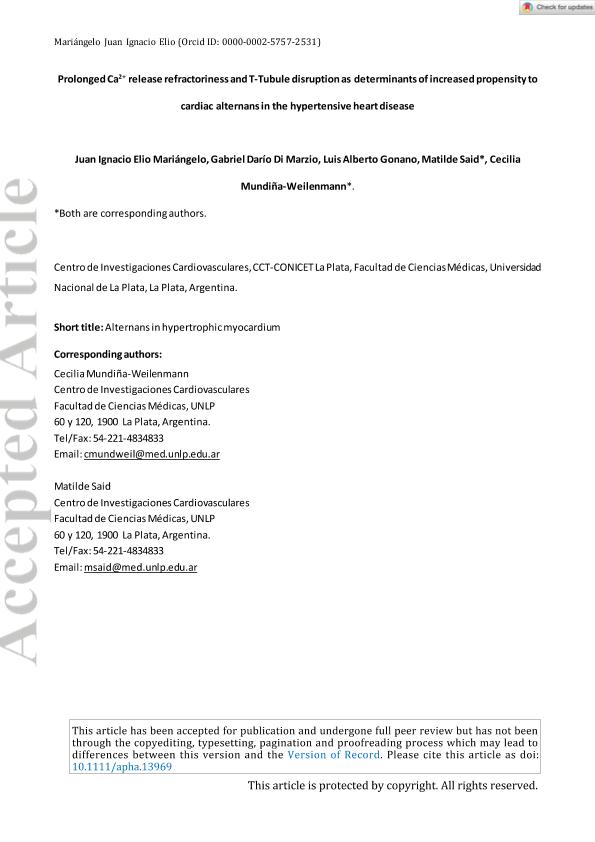Mostrar el registro sencillo del ítem
dc.contributor.author
Mariángelo, Juan Ignacio Elio

dc.contributor.author
Di Marzio, Gabriel Darío
dc.contributor.author
Gonano, Luis Alberto

dc.contributor.author
Said, Maria Matilde

dc.contributor.author
Mundiña, Cecilia Beatriz

dc.date.available
2024-02-19T11:29:57Z
dc.date.issued
2023-03
dc.identifier.citation
Mariángelo, Juan Ignacio Elio; Di Marzio, Gabriel Darío; Gonano, Luis Alberto; Said, Maria Matilde; Mundiña, Cecilia Beatriz; Prolonged Ca2+ release refractoriness and T-tubule disruption as determinants of increased propensity to cardiac alternans in the hypertensive heart disease; Wiley Blackwell Publishing, Inc; Acta Physiologica; 238; 2; 3-2023; 1-30
dc.identifier.issn
1748-1708
dc.identifier.uri
http://hdl.handle.net/11336/227355
dc.description.abstract
Aim: Cardiac alternans is a dynamical phenomenon linked to the genesis of severe arrhythmias and sudden cardiac death. It has been proposed that alternans is caused by alterations in Ca2+ handling by the sarcoplasmic reticulum (SR), in both the SR Ca2+ uptake and release processes. The hypertrophic myocardium is particularly prone to alternans, but the precise mechanisms underlying its increased vulnerability are not known. Methods: Mechanical alternans (intact hearts) and Ca2+ alternans (cardiac myocytes) were studied in spontaneously hypertensive rats (SHR) during the first year of age after the onset of hypertension and compared with age-matched normotensive rats. Subcellular Ca2+ alternans, T-tubule organization, SR Ca2+ uptake, and Ca2+ release refractoriness were measured. Results: The increased susceptibility of SHR to high-frequency-induced mechanical and Ca2+ alternans appeared when the hypertrophy developed, associated with an adverse remodeling of the T-tubule network (6 mo). At the subcellular level, Ca2+ discordant alternans was also observed. From 6 mo of age, SHR myocytes showed a prolongation of Ca2+ release refractoriness without alterations in the capacity of SR Ca2+ removal, measured by the frequency-dependent acceleration of relaxation. Sensitizing SR Ca2+ release channels (RyR2) by a low dose of caffeine or by an increase in extracellular Ca2+ concentration, shortened refractoriness of SR Ca2+ release, and reduced alternans in SHR hearts. Conclusions: The tuning of SR Ca2+ release refractoriness is a crucial target to prevent cardiac alternans in a hypertrophic myocardium with an adverse T-tubule remodeling.
dc.format
application/pdf
dc.language.iso
eng
dc.publisher
Wiley Blackwell Publishing, Inc

dc.rights
info:eu-repo/semantics/openAccess
dc.rights.uri
https://creativecommons.org/licenses/by-nc-sa/2.5/ar/
dc.subject
ALTERNANS REVERSAL
dc.subject
CALCIUM RELEASE REFRACTORINESS
dc.subject
CARDIAC ALTERNANS
dc.subject
HYPERTENSIVE HYPERTROPHY
dc.subject
T-TUBULE ORGANIZATION
dc.subject.classification
Fisiología

dc.subject.classification
Medicina Básica

dc.subject.classification
CIENCIAS MÉDICAS Y DE LA SALUD

dc.title
Prolonged Ca2+ release refractoriness and T-tubule disruption as determinants of increased propensity to cardiac alternans in the hypertensive heart disease
dc.type
info:eu-repo/semantics/article
dc.type
info:ar-repo/semantics/artículo
dc.type
info:eu-repo/semantics/publishedVersion
dc.date.updated
2024-02-15T13:38:49Z
dc.journal.volume
238
dc.journal.number
2
dc.journal.pagination
1-30
dc.journal.pais
Reino Unido

dc.journal.ciudad
Londres
dc.description.fil
Fil: Mariángelo, Juan Ignacio Elio. Consejo Nacional de Investigaciones Científicas y Técnicas. Centro Científico Tecnológico Conicet - La Plata. Centro de Investigaciones Cardiovasculares "Dr. Horacio Eugenio Cingolani". Universidad Nacional de La Plata. Facultad de Ciencias Médicas. Centro de Investigaciones Cardiovasculares "Dr. Horacio Eugenio Cingolani"; Argentina
dc.description.fil
Fil: Di Marzio, Gabriel Darío. Consejo Nacional de Investigaciones Científicas y Técnicas. Centro Científico Tecnológico Conicet - La Plata. Centro de Investigaciones Cardiovasculares "Dr. Horacio Eugenio Cingolani". Universidad Nacional de La Plata. Facultad de Ciencias Médicas. Centro de Investigaciones Cardiovasculares "Dr. Horacio Eugenio Cingolani"; Argentina
dc.description.fil
Fil: Gonano, Luis Alberto. Consejo Nacional de Investigaciones Científicas y Técnicas. Centro Científico Tecnológico Conicet - La Plata. Centro de Investigaciones Cardiovasculares "Dr. Horacio Eugenio Cingolani". Universidad Nacional de La Plata. Facultad de Ciencias Médicas. Centro de Investigaciones Cardiovasculares "Dr. Horacio Eugenio Cingolani"; Argentina
dc.description.fil
Fil: Said, Maria Matilde. Consejo Nacional de Investigaciones Científicas y Técnicas. Centro Científico Tecnológico Conicet - La Plata. Centro de Investigaciones Cardiovasculares "Dr. Horacio Eugenio Cingolani". Universidad Nacional de La Plata. Facultad de Ciencias Médicas. Centro de Investigaciones Cardiovasculares "Dr. Horacio Eugenio Cingolani"; Argentina
dc.description.fil
Fil: Mundiña, Cecilia Beatriz. Consejo Nacional de Investigaciones Científicas y Técnicas. Centro Científico Tecnológico Conicet - La Plata. Centro de Investigaciones Cardiovasculares "Dr. Horacio Eugenio Cingolani". Universidad Nacional de La Plata. Facultad de Ciencias Médicas. Centro de Investigaciones Cardiovasculares "Dr. Horacio Eugenio Cingolani"; Argentina
dc.journal.title
Acta Physiologica

dc.relation.alternativeid
info:eu-repo/semantics/altIdentifier/url/https://onlinelibrary.wiley.com/doi/10.1111/apha.13969
dc.relation.alternativeid
info:eu-repo/semantics/altIdentifier/doi/http://dx.doi.org/10.1111/apha.13969
Archivos asociados
